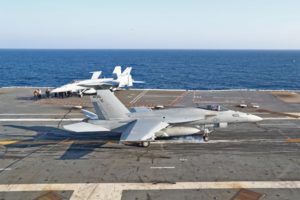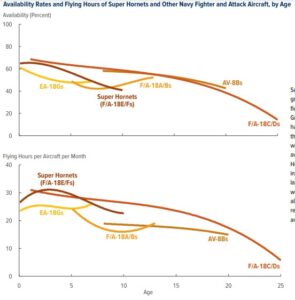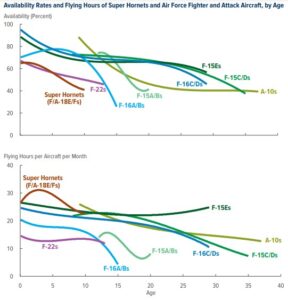A recent Congressional Budget Office (CBO) report found the Navy’s F/A-18E/F Super Hornet fighter jets seem to be aging worse than the older F/A-18C/D predecessors, particularly with lower availability rates.
CBO said recent Navy Department data showed availability rates for Super Hornets and the F/A-18C/D Hornets both shrunk “steeply” from the mid-2000s to the mid-2010s, and it found Super Hornets seem to be underperforming the older Hornets.

Availability rates are defined as the percentage of time an aircraft can be flown on training or operational missions and are in part dependent on maintenance funding.
“By investing in, for instance, greater supplies of spare parts, a military service can increase aircraft availability rates. Likewise, a military service can choose whether and how much to fly an available aircraft, realizing that flying aircraft more increases costs, both for fuel and maintenance,” the report said.
CBO underscored since the Super Hornets are newer, they are expected to have higher availability rates than the older C/D Hornet variants because they have just had less time to accumulate flying hours and related wear and tear.
However, “once aircraft age is considered, Super Hornets underperformed predecessor Hornets, with lower availability rates than the earlier generation of F/A-18C/Ds of the same age. Those differences are statistically significant,” the office said.
CBO found about an 18 percentage point gap between availability rates of Super Hornets and C/D Hornets at 10 years old, illustrating faster availability declines.
“Super Hornet availability at age 10 is comparable to F/A-18C/D availability at age 20,” the report said.
The Navy told CBO the differences in availability of the Super Hornets versus C/Ds may be related to higher levels of galvanic corrosion via greater use of composite metals in the Super Hornets.

The report ruled out the chance that differing flying hour usage between older Hornets and Super Hornets caused the lower availability rates in the latter.
CBO said although Super Hornets were seemingly used at higher rates earlier in their service lives than C/D Hornets, “monthly flying hours per aircraft of Super Hornets exceeded those of F/A-18C/Ds during just a few early years of operation, and only modestly. Since Super Hornets reached age six, their flying hours have fallen below those of F/A-18C/Ds of the same age.”
The typical total lifetime flying hours for Super Hornets are now lower than those of C/D Hornets by age seven and thereafter.
By the time a Super Hornet has been flown for 10 years, CBO found it on average flew four hours less per month than C/D Hornets at the same age.
“Greater use cannot explain the steeper decline in availability of 10-year-old Super Hornets…in fact, 10-year-old Super Hornets are being flown as much as 16-year-old F/A-18C/Ds,” the report said.
CBO argued these differences in usage rates as a function of age are statistically significant.
The office also compared Super Hornets to the EA-18G Growler electronic warfare aircraft, AV-8B Harrier IIs and F/A-18A/Bs. The more complex Growlers had even lower availability rates and hours than Super Hornets while the Harriers have higher availability rates but fewer flying hours than the Super Hornet and the F/A-18A/Bs have been flown less than the Super Hornets.
Overall, the C/D Hornets generally had greater availability rates over their lifetimes than these other Navy aircraft.
CBO also compared Super Hornet availability rates and flying hours to Air Force fighter and attack aircraft, with all but the F-22 having higher availability rates than the F/A-18E/F. However, the report noted the Navy flies the Super Hornets for more hours per month, on average, than any comparable Air Force aircraft.

The report said when it included older Super Hornets in its analysis, it showed availability rates among the fleet could decline significantly more.
“The experiences of the oldest Super Hornets suggest that their availability is likely to continue to decline as the fleet ages. A similar trend has been observed for many fighter and attack aircraft. But some fleets have had lengthy periods with stable availability rates,” CBO said.
However, the report suggested since the Super Hornet is still relatively new, the Navy could take actions to increase or at least stabilize its availability rates, largely tied to increased maintenance funding.
“Because the Super Hornets are relatively new, DoN might be able to take some actions to increase the aircraft’s availability rate. For example, DoN could replace existing parts with new ones that have been redesigned for greater reliability or longevity, or it could devote more resources to routine maintenance (such as keeping on hand a more robust supply of spare parts).”